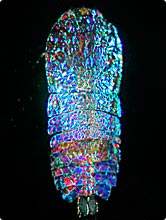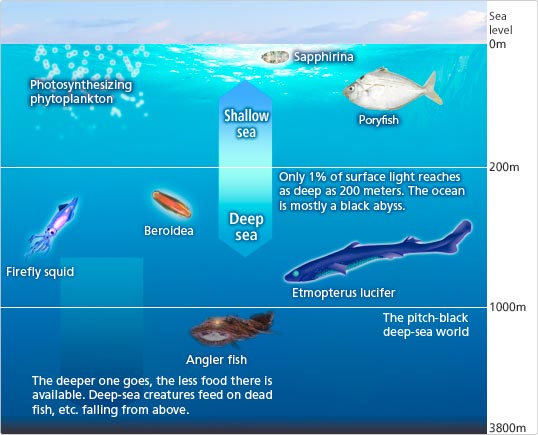Unlit by the sun, the depths of the sea have forced sea creatures to develop special abilities. When compared to life on land, a far greater proportion of sea creatures have the ability to emit light; whether used to attract the opposite sex, for camouflage, to shield themselves against enemies or in the pursuit of prey, the light from these creatures sparkles in a beautiful, mysterious fashion. For sea creatures that exist in darkness and half-light, this is an ability they cannot live without.
Jewels of the sea
A short story from Japan's Muromachi period (1336-1573) called “Tamamizu Monogatari” (The Tale of Tamamizu), relates how a fox admired a beautiful princess so much that it transformed into a young girl to gain the chance to work in her service. Delighted with the girl's kindness and beauty, the princess bestowed upon her the name “Tamamizu.”
One day a competition was held at the imperial court that the princess won with the help of Tamamizu. By winning the competition, the princess also won the right to formally become an empress. Thinking that it would be unseemly to join the imperial court at her mistress' side, Tamamizu was obliged to leave her. As she did, Tamamizu left a letter explaining that she was in fact not a young girl but a fox that had transformed itself so that it could lovingly attend to the beautiful princess.
What was it that inspired the princess to name the girl “Tamamizu”? The “tama” in Tamamizu refers to a jewel, and “mizu” to water. Thus, “Tamamizu” means “Water that sparkles like a jewel.” Perhaps the girl might have been a fleeting jewel that sparkled reflecting the princess as the sun.
The surface of the sea where the Kuroshio (or Japan) Current (an ocean current in the western Pacific Ocean that flows from Taiwan past Japan and into the northern Pacific Ocean) branches off has a rainbow-hued surface, and Japanese bonito fishermen have long referred to this area as “Tamamizu.” In fact, this multi-colored sparkling is due to the light reflecting off of a type of plankton called “sapphirina.” Small fish also gather in these radiant seas to eat the sapphirina, in turn attracting the bonito that feed on them. Sapphirina, whose scientific name means “sapphire,” are also referred to as “jewels of the sea.”

Zooplankton belonging to a class of copepod species
Photo courtesy of Dr. Jun Nishikawa, Researcher, Ocean Research Institute, The University of Tokyo
A deep sea world without light
Why is it that sapphirina plankton are able to reflect sunlight in so many colors? The secret lies in their shells, made of layers of crystal piled one on top of the other that reflect and distort the light. It is interesting to note that this structure is the same as that found in precious opals, which also shine in a myriad of colors.
It is thought that the reflectivity of sapphirina aids them in finding a mate. Only male sapphirina are reflective, while the eyes of the female are well developed. However, only a fraction of the creatures on the surface of the sea are able to use light from the sun in this manner.
Sunlight fades the deeper one goes beneath the ocean's surface. At a depth of 200 meters, almost no sunlight penetrates the ocean, and there are no photosynthetic organisms to be found. The area below this depth is referred to as “deep sea,” and is completely devoid of light.
Roughly 71% of the earth's surface is covered by ocean, which has a mean depth of 3,800 meters, roughly equivalent to the height of Mount Fuji. Based on these numbers, we arrive at the fact that deep sea makes up 95% of the world's oceans. It is easy to understand why light can be such an effective signal in the ocean.
Approximately 70% of fish and 90% of other organisms including squid and shrimp living below the 500-meter mark are capable of some form of luminescence, which of course is not reflected sunlight, but light emitted from their own bodies.

The world's oceans have a mean depth of approx. 3,800 meters (Mt. Fuji is 3,776 meters high). The Challenger Deep in the Mariana Trench has a depth of approx. 10,920 meters. The pitch-black deep-sea world extends from 1,000 meters below the surface.
Special thanks to Yuichi Kitamura for collaboration with artwork.
Illuminating the body from within
Many of the luminescent sea creatures have the ability to emit light from their own bodies. Some, however, owe their luminescence to the presence of bioluminescent bacteria that live in their bodies.
The poryfish is a good example of a fish living in relatively shallow depths that exhibits such ability. The poryfish, which was first reported as exhibiting luminescent abilities in 1928, is a small fish found in coastal waters in East and Southeast Asia. In Japan it is called the “Hiiragi” (holly tree) because its dorsal fin is spiked like the leaf of the holly tree.
The poryfish is equipped with luminescent organs inhabited by bacteria. Light emitted from these organs is reflected off the silvery internal walls of the fish's swim bladder, located in the dorsal portion of the fish between the gut and the spine, and then passed through to the outside of the body.
What a wonderful faculty!
The poryfish also has an ingenious way of controlling this light by adjusting the amount of air in its swim bladder. The presence of air stimulates the bacteria, making them emit more light. Conversely, reducing the amount of air in the swim bladder reduces the amount of light they emit.
Of course, for the light to be visible, the body of the poryfish has to be transparent. The male poryfish has a semi-transparent patch on its body, extending from the luminescent organs to its skin. These organs project a long way into the swim bladder. In other words, the male poryfish glows more brightly. This indicates that, as with the sapphirina, the male poryfish uses light to attract females.
But most intriguing are the “conversations” of the poryfish. Dr. Minoru Wada, researcher at the University of Tokyo talks of seeing poryfish luminescing in alternation in a fantastic episode when he was diving during his research off the coast of Nishiizu Arari, Shizuoka Prefecture. Dr. Wada believes that poryfish use light to communicate with each other.
Poryfish use their luminescent abilities for more than just attracting a mate. Surprisingly enough, this ability also helps them to conceal themselves.
- The bioluminescence system of the poryfish
- (“Bioluminescence of leiognathid fishes: diversity and evolution of luminous system” by Drs. Kou Ikejima and Minoru Wada, appeared in the monthly journal Kaiyo.)
Light acting as camouflage
Why is it that fish living around coral reefs are so colorful? In the midst of the multi-hued, sun-lit colors of the reef, a colorful appearance actually makes an organism less conspicuous. Likewise, there must be a reason why many octopi, starfish, and other creatures that live in slightly deeper environs are red. Under the sea, where only blue light penetrates, red objects absorb blue light and appear black, and thus are not easily seen. These creatures have chosen “clothing” that fits their surroundings in order to protect themselves.
Imagine you are swimming in the ocean, looking upward at a fish swimming near the surface. The surface of the water sparkles brightly in the sunlight. In this situation, the body of the fish is a highly visible black silhouette. And so, many species of fish have dark-colored backs and white undersides. This is not, of course, due to anything as trivial as a suntan, but rather it is intended to camouflage the creature and make it equally difficult to see whether viewed from above or from below
To make themselves less conspicuous in the ocean where there are few places to hide, luminescent fish have equipped themselves with an interesting method of defense; they light up the lower area of their bodies, erasing their silhouette. This is called “counter-illumination.” It is astonishing that fish have such advanced abilities to hide themselves.
Counter-illumination of the poryfish. Looking upward at a fish swimming near the surface, the surface of the water sparkles brightly in the sunlight and the body of the fish is a highly visible black silhouette. To make it less conspicuous in the ocean, luminescent fish light up their bodies, erasing their silhouette.
Why sea creatures glow
There are yet more reasons why some sea creatures glow. The angler fish, which is famed for its luminescent abilities, uses light as an illusory bait to lure fish close to it, almost as if it were fishing. When threatened, the brittle star (a type of starfish) detaches a glowing piece of its body and escapes while its enemy is distracted. Some organisms use furious flashes of light to intimidate their opponents. In some cases these flashes are strong enough to cause the victim to temporarily lose consciousness.
But how is it that creatures glow? What are the main reasons why they live symbiotically with other luminescent organisms? There is a prominent theory that attempts to answer this question.
Organisms glow when a luminescent enzyme called luciferin and a fluorescent substance called luciferase react together to release energy, a process for which oxygen is essential. Living organisms collect toxic oxygen radicals in their bodies. Luminescent organisms make effective use of these radicals.
The creatures of the sea have harnessed the ability to glow, using it for a multitude of purposes. For creatures living in a world that never glimpses the sun, the ability to emit light plays a far greater role than for those animals that live on land.
Editorial contributor / Date of article posted
Dr. Minoru Wada, Researcher, Ocean Research Institute, The University of Tokyo / August 2006

